|
|
|
| My Favourite Planet > Blogs > Cheshire Cat Blog > June 2015 |
 |
back |
The Cheshire Cat Blog |
 |
June 2015 |
 |
|
| |

Mount Olympus springs from the plain around Dion, Macedonia.
The Cheshire Cat takes a stroll with friends through the Dion Archaeological Park at the foot of
Mount Olympus and is inspired by the muses of the Pierian Spring to write his first blog of 2015. |
| |
The visit to Dion was a delightful surprise, a revelation and long overdue. As readers of The Cheshire Cat Blog will know, this writer prefers to travel in spring (see, for example Do Meteora dogs dream of floating sheep? and Ionian Spring). However, between October and May the gods on Olympus often draw a veil of clouds around them for a bit of peace after the busy summer months.
I have lost count of how many times I have had to cancel plans to visit Dion because of Zeus' stormclouds looming over Greece's highest mountain. As we shall see, it is the snow and rain from the mountain which make Dion on the plain below the Olympians' green and fertile front garden.
So here I am once again in Macedonia with my plans and maps. This time a bit later in the year, and lo! there is not a cloud in sight; the sun shines down on the ineffably old. And when Haris Tsougaris, archaeologist and director of Pella Museum, invites me to join him on a visit to Dion it is an offer I just can't refuse.
Bright and early the next morning we are five happy travellers driving down the A1 motorway from Thessaloniki to Dion, and it seems we are there in no time at all. We are warmly greeted by Eleni Benaki, a veteran of the archaeological exploration at Dion, who has kindly offered to guide us around the archaeological park and museum.
What a treat it is to take a relaxed stroll through the park in the company of two of the people who have been intimately involved in creating it; Haris also took part in the excavations here. Ms. Benaki navigates us along the footpaths and ancient streets of the sacred city, explaining along the way the historical and spiritual significance of the various temples, sanctuaries and other buildings and precincts.
We learn from her not only the history of the area but also something of the excavations and the development of the site into a park in which culture and nature can be enjoyed at the same time. To a great extent nature has been left to run its course here, although interventions have had to be made to protect the historical monuments and to make it easier for visitors to walk through the site.
In this respect, water is one of the area's greatest assets - you could say it is the predominant element here - but the high water table has to be carefully monitored to avoid flooding. In the museum there are photos of earlier excavations in which you can see the archaeologists, including Ms. Benaki, working up to their knees in water ( see photo below). |
|

Our host and guide Ms. Eleni Benaki
of Dion Archaeological Museum.
See below for opening times
and travel information.
See also a video about Dion,
including an interview with
Professor Dimitrios Pandermalis
at the bottom of the page. |
|
|

Vintage photo of archaeologists working in water-logged Dion.
Eleni Benaki (second from left) working with
Evangelou Dionysios, Kremetis Basileios and others.
Photo: Archaeological Museum of Dion. |
| |

Some areas of the ruined city are still submerged. |
|

The River Baphyras which runs through Dion.
|
Rain and melted snow seeps, trickles and cascades down from the Olympus mountain range onto the Pierian Plain on which Dion stands. A labyrinth of streams trying to find their way to the Aegean Sea at the Thermaic Gulf form a marshy wetland.
Here and there the water springs up from the ground in lazy bubbles. In antiquity such springs and streams were considered sacred and inhabited by Nymphs and other supernatural beings. There are several versions of myths and legends concerning the mountains, rivers, and springs here, many of which tell that this was the home of the Muses, daughters of Zeus and Mnemosyne (the personification of memory) and sources of inspiration to mortals.
The great bard Orpheus (Ὀρφέως) was the son of the Muse Calliope, and when he was killed and torn to pieces by a gang of angry Maenads (or Bacchae), female followers of Dionysus, the Muses gathered the pieces of his body and buried them nearby. In the second century AD the Greek travel writer Pausanias wrote that locals believed that an urn on top of a pillar along the road between Dion and Mount Olympus contained the bard's remains.
Pausanias also tells us that when Orpheus' murderers tried to wash his blood from their hands in the river, the stream sank underground to avoid becoming complicit in the crime. [1] This legend explained how the River Helikon (today known as the Ourlias), which descends from Olympus, disappears underground then reemerges about 4 km southwest of Dion as the Baphyras. The stream was personified in the form of the local river god Baphyras (Βαφύρας, see photo below right). In the local cult of Artemis the goddess was worshipped as Artemis Baphyria (Άρτεμιδος Βαφυρία).
See a mosaic of a bovine river god (Baphyras?) below.
The river was once navigable and Dion had a harbour connecting it to the Aeagean Sea, then only 1.5 km away. Over the centuries alluvial material brought down from the mountains has silted up the river and extended the land, so that Dion is now much further away from the sea. This is the same fate which led other ancient Greek cities such as Ephesus and Miletus to be abandoned and Pella to lose its strategic importance. It is thought, however, that Dion was destroyed by earthquakes long before it became a landlocked marsh. |

Springwater bubbles up through the bed
of the Baphyras at the Sanctuary of Isis. |
| |

Head of Dion's river god Baphyras [2] |
| |
|

Water, water everywhere ...
A small lake (or a big pond) in Dion Archaeological Park.
|
The positive aspect of this process, is that the submerged remains of Dion and the other cities were preserved in mud for centuries, protected to a great extent from looting.
The British traveller and topographer William Martin Leake, who arrived in Dion (then known as Μαλαθριά, Malathria) in December 1806, reported that the locals had considered the land unsuitable for farming and it had become stony, barren, overgrown in some places with wild bush and deserted apart from a few shepherds. He discovered the theatre and other submerged buildings and concluded that this was the site of ancient Dion, thus laying claim to its rediscovery. [3]
Leake also discovered that shortly before his arrival the local Ottoman governor Vely Pasha, recognizing the richness of the soil, had settled some Greek labourers who cleared away the scrub for planting corn and built houses - the foundation of the modern village. |
|
|
| |

Furtive fish.
|
I wish I could tell you what kind of fish lurk in the cloudy waters of this lake. I should have asked Eleni. Squid, known to the ancient Greeks as teuthides (τευθίδες), are said to have once lived at the mouth of the Baphyrus River.
"Aristotle, in the fifth book of his Parts of Animals, says that both the teuthus and the sepia are short-lived fish. And Archestratus, who travelled and sailed over the whole earth, for the sake of gratifying his greedy appetite, says:
'The best of all the teuthides are those
Caught near Pierian Dium, near the stream
Of Baphyras. And in Ambracia's port
You will see mighty shoals of this same fish.'"
Athenaeus of Naucratis, The Learned Banqueters [4]
Whether squid are still to be found here is another thing I forgot to enquire. If so, you will probably find them on the menu of one of the local tavernas as kalamaria. Kali orexi! |
|
|
| |

Hallo, Fischfreunde! |
|

Here come the geese. |
| |

The geese politely enquire if you could possibly spare a few crumbs from your packed lunch. |
|

Frogs-a-plenty you would expect in this Macedonian waterworld... |
| |
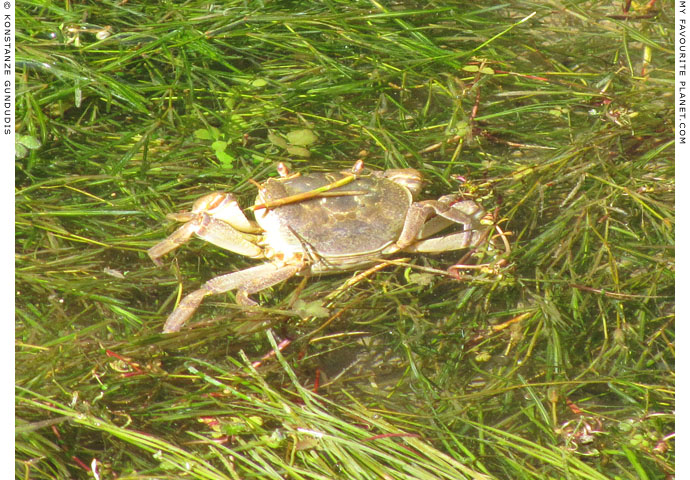
... but the large crabs are quite a surprise. |
|

Dragonflies come in blue ... |
| |
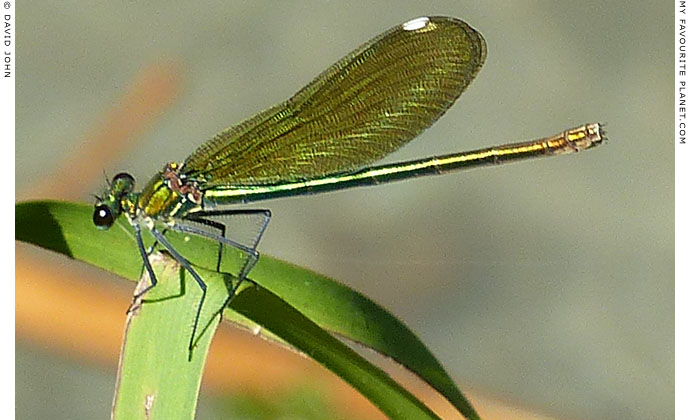
... and green. |
|

Common mallows (Malva sylvestris), typical plants of this type of marshy ground.
We also saw plenty of these near the Temple of Artemis in Ephesus
(see Ionian Spring Part 2 at the Cheshire Cat Blog). |
| |

It is surprising to see so many plants flowering in Dion in summer; in many, more
arid parts of Greece the blooms have shrivelled in the heat by this time of year. |
| |

And wild blackberries are already ripening. |
| |
As everybody will tell you, the local water tastes wonderful. Imbibing the water of the Pierian spring, at the birthplace of the Muses, was said to supply the drinker with inspiration and knowledge. This drinking fountain in the park allows you to test the legend completely free of charge. But beware:
"A little Learning is a dang'rous Thing;
Drink deep, or taste not the Pierian Spring:
There shallow Draughts intoxicate the Brain,
And drinking largely sobers us again.
Fir'd at first sight with what the Muse imparts,
In fearless youth we tempt the heights of Arts,
While from the bounded level of our mind
Short views we take, nor see the lengths behind;
But more advanc'd, behold with strange surprise
New distant scenes of endless science rise!
So pleas'd at first the towering Alps we try,
Mount o'er the vales, and seem to tread the sky,
Th' eternal snows appear already past,
And the first clouds and mountains seem the last;
But, those attain'd, we tremble to survey
The growing labours of the lengthen'd way,
Th' increasing prospects tire our wand'ring eyes,
Hills peep o'er hills, and Alps on Alps arise!"
From An Essay on Criticism (1711)
by Alexander Pope (1688-1744), lines 215-232. |
|

Drinking from the Pierian spring. |
|
|
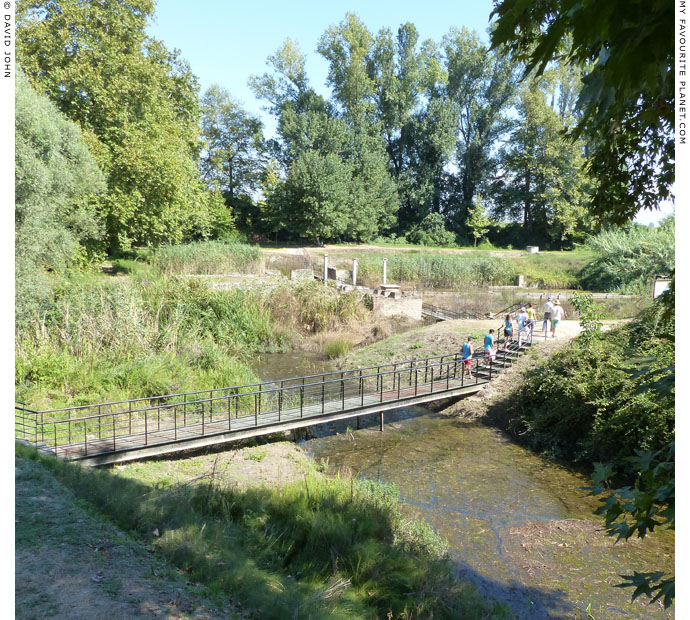
Despite all the soggy land around the 150 hectare Dion Archaeological Park
you don't need to bring your gumboots. Footbridges and raised walkways
make getting around the site squelch-free. The steps may not provide 100%
accessibility for the disabled, but for many parts of the park there are
alternative paths. Generally, most of the site and museum are quite accessible.
The walkway leads to the right over the sacred spring, beyond
which is the sanctuary of Zeus Hypsistos (see below). |
| |

A bridge over untroubled waters.
The raised walkway through the sanctuary of Isis. |
| |

A copy of the cult statue of Isis-Tyche stands in a semi-circular niche at the sanctuary of Isis.
|
The sanctuary of Isis was founded in Dion in the 2nd century BC, replacing that of Artemis. The buildings of the sacred precinct, discovered in 1978, are of the 2nd century AD and include temples of Isis Tyche, Isis Lochia and Aphrodite Hypolympidia (see photo below). Statues of these goddesses found here are now in the museum.
Isis-Tyche was an amalgamation of the Egyptian goddess Isis and Tyche, the Greek goddess of fortune, abundance and personification of the city, known to the Romans as Fortuna. In her left arm she holds her symbolic cornucopia, the horn of plenty. The original 2nd century AD statue was excavated in autumn 1979 and is now in the archaeological museum.
Several copies of statues now in the museum have been set up around the archaeological site at the places where they were unearthed to give visitors a better understanding of the monuments in which they once stood. Purists may not approve of this practice, but I feel that this - and the restoration of the site overall - has been done in a very sensitive and attractive way.
The fact that so many new discoveries have been made in Dion since continual excavations began here in 1973 mean that there is much more to be unearthed on this large site, only a fraction of which has yet been explored. |
|

Parts of statues which were
"redeployed" as part of a later wall. |
|
|

The highway is the dry way.
|
The cardo was the 5 metre wide main street of ancient Dion, running north-south through the city. The enormous paving stones were laid in the 3rd century AD, during the period of Roman occupation. In the 4th century a wall was built along the street using stone from earlier monuments and buildings.
The restored remains of the "Monument of Shields" (photo, right) have been set up on the west side of the cardo, near the centre of the ancient city. The facade, thought to have originally been part of a 37 metre long victory monument, has a row of alternating panels of reliefs of shields and corselets (body armour) onto which were attached the armour and weapons of defeated enemies displayed as trophies. The monument has been dated to some time after 200 BC.
The most famous military monument known to have been erected in Dion was the Granikos Monument (or Granicus Monument), a large bronze equestrian statue group made by Lysippos and commissioned by Alexander the Great to commemorate the 25 members of his Companion cavalry who died at the Battle of Granikos against the army of Persian King Darius III in 334 BC. The statues were later taken to Rome by Quintus Cecilius Metellus as war booty, after Macedonia was made a Roman province in 146 BC (see the article on the Alexander the Great page of the MFP People section). |
|
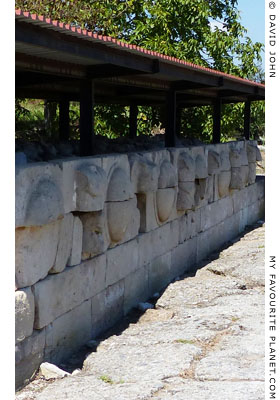
The reconstructed "Monument of
Shields" to the west of the cardo. | |
|

The "Villa of Dionysos".
|
Many of the buildings in the archaeological site, mostly from Hellenistic and Roman times, have been reduced to their foundations or lower walls. Most will be of interest only to those with a special interest in history, archaeology and ancient city planning. However there are many areas of interest for other visitors, particularly the sanctuaries of the gods and the remains of grand houses and their enormous floor mosaics.
The large roofed area in this photo is part of the "Villa of Dionysos", named after a large mosaic featuring the god of wine on the floor of what was a banqueting hall (see photo below) of this enormous building complex, which also included a cult area, library, shops, workshops and baths. According to one theory this complex may have been a school of philosophy. The original mosaic is still in situ, which explains why the roof is needed.
In the backgound is the Olympus mountain range, already clouded over by mid-morning.
Another large mosaic, featuring the head of the Gorgon Medusa (photo right), and sculptures found in this complex are now in the archaeological museum. See more photos and information about the Gorgon Medusa on the Medusa page of the MFP People section. |
|

The head of Medusa in the centre
of a circular mosaic from the Villa
of Dionysos. 2nd century AD.
Dion Archaeological Museum. |
|
| |

The 100 square metre mosiac floor of the banqueting hall of the "Villa of Dionysos". |
In the foreground the mosaic panels have abstract motifs, and the central panel is made up of complex pattern of spirals and concentric circles (see a similar mosaic in the Great Baths below).
In the upper part of the photo is the Dionysus mosaic after which the "Villa of Dionysos" was named by archaeologists. The central panel depicts a "triumph of Dionysus", a common theme in ancient art. In this case the image has aquatic overtones, and is referred to as a "marine triumph": Dionysus, holding his trademark thyrsos staff, stands with his companion Papposilenos in a chariot drawn by two panthers led by two sea Centaurs (see also the mosaic of Dionysos riding a panther in Pella Museum). Above and below this image are six actors' masks, a reminder of the wine god's association with the theatre. The image areas are surrounded by sophisticated borders of spiralling plants, guilloches and spiral waves.
Unfortunately, the sides and far end of this room are fenced off, so it is difficult to get a good look at this excellent work of art.
When the mosaic was first discovered in 1987, Professor Dimitrios Pandermalis, director of the excavations at Dion, dated it to 200 AD. [5]
See also Hellenistic floor mosaics of the 4th century BC in Pella:
the Stag Hunt by Gnoseis and the Abduction of Helen. |
|
|
| |

A call of nature.
The eastern latrine, a public toilet of the Roman period, south of the Villa of Dionysos.
Public latrines in Graeco-Roman cities were usually well built, using standardized designs
which included flowing water along the channels in front of and below the rows of stone
seating. This one is in remarkably good condition, and with a little work could probably
be put back into operation. I am not sure though, that visitors today would appreciate
the open-plan communal arrangements in quite the way the ancient Romans did.
If needs must while you are exploring the archaeological park, there are more
modern conveniences at the park's cafe (see Dion travel information below). |
| |

Weighty matter.
A marble table top on the side of the cardo, opposite the Great Baths, has round
depressions of different sizes for controlling the measures of market goods. The
inscription on the front states that the table was ordered by Lucius Cassius Primus,
presumably the Roman official responsible for weights and measures in Dion. |
|

The paths around the Archaeological Park are well signposted, and the large illustrated
information boards in Greek and English near the main sights explain the backgrounds
and contexts of the monuments. The plans of the site are also very helpful. This is the
information board for the sanctuary of Zeus Hypsistos. |
|

The temple of Zeus Hypsistos.
|
Dion had not only one but two sanctuaries for the supreme god Zeus, after whom the city was named. The larger sanctuary was dedicated to Zeus Olympios, the chief deity among the Olympian gods and the one we generally asscociate with ancient Greek religion and myth.
This smaller sacred area for the cult of Zeus Hypsistos (Ὕψιστος, Most High) is a more modest affair, with a small temple which contained a smaller-than-lifesize statue of the god sitting on a throne. A copy of the statue has been placed in the temple, while the original is in the archaeological museum.
Little is known of the exact nature of the worship of Zeus Hypsistos around whom a cult (or cults) flourished at several places in the Greek world between the 1st and 4th centuries AD, during the Roman Imperial period. Dedications to Hypsistos and cult sanctuaries are also known from Athens, Philippi, Didyma, Klaros and around the Bosphorus. Theories abound that the cult was an early form of Greek monotheism influenced by Judasim or even Zoroastrianism. [6] |
|
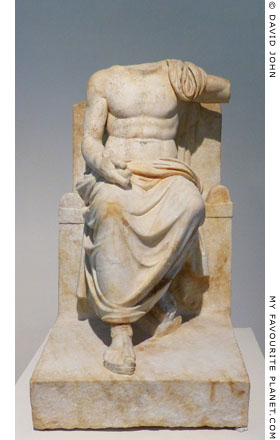
Cult statue of Zeus Hypsistos.
Roman Imperial period.
Dion Archaeological Museum. |
|
|

Large floor mosaic in the Great Baths complex.
|
Looking at this mosaic and the similar one in the Villa of Dionysos (above), I was wondering how I could describe the sophisticated geometric pattern of intersecting radial spirals and concentric circles which are defined not by contours but by the black and white triangles formed by the intersections. I also wondered about the symbolic significance of such mandala-like patterns in ancient mosaics. This is something I'll have to get back to some other time.
Another large mosaic in the Great Baths complex has a panel featuring a monstrous creature with the front part of a bull and the swirling tail of an aquatic animal (photo, right). The face of the bull looks soppy, but maybe it is meant to appear noble or benign.
River gods (Ποταμοί, potamoi) were often depicted on ancient coins and reliefs as bulls or combinations of bull and man or bull and fish/water serpent. One of the best-known was Archeloos (Ἀχελῷος), god of the powerful, "silver-swirling" river which flows from the Pindus mountains. [7] Perhaps this mosaic is meant to represent the Baphyras River: somewhat docile compared with other raging torrents, but nevertheless constant, mostly beneficent and essential to life and worship in the city. |
|

Mosaic of a fabulous creature, half bull,
half aquatic animal, in the Great Baths. |
|
| |

Part of a large floor mosaic in the Great Baths complex depicting wrestlers.
Baths in the Greek and Roman world often had associations with sports
and had gymnasiums. Wrestlers trained in an area known as a palaestra.
See also Digging Aristotle, a photo essay about Aristotle's Lyceum
in the palaestra at the sanctuary of Apollo Lykeios in Athens. |
| |

The odeion, the concert hall of the Great Baths complex. |
| |
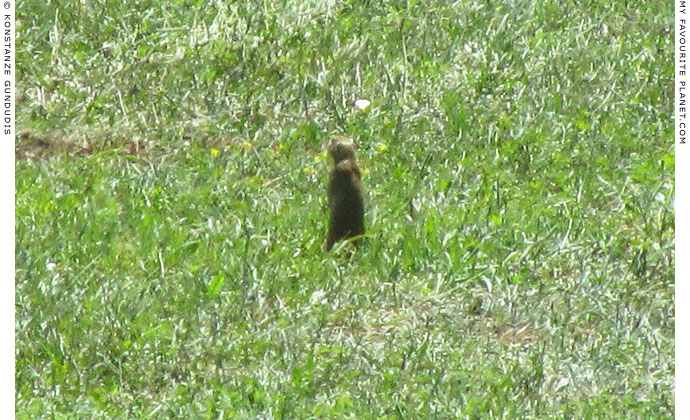
Groundhog Day in Dion.
I have never been able to get a photo of these ground squirrels; they are just too quick for me.
They pop up from their burrows, have a quick look around, then disappear again before I've
even got my lens cap off. Luckily, Konstanze captured one reconnoitring its turf. Although it
looks as if it is contemplating eternity, it was above ground for just a couple of seconds.
Some years ago Haris revealed to me that these critters, which also live at the
Archaeological Site of Pella, are known as citellus citellus or spermopilus citellus. |
| |

Groundhog Day in Dion. |
| |

Groundhog Day in ... Hey, wait a minute ... |
|

... And finally into the Archaeological Mseum of Dion ...
|
Normally I would recommend visiting a museum before its adjoining archaeological site in order to learn something of the background to a place: context is everything. But in this case I am very glad we walked around the archaeological park before entering the museum. Apart from enjoying the best light of the morning, we avoided the afternoon heat. It is also the case that once in a museum some of us - myself included - find it difficult to leave.
As Eleni Benaki shows off the wealth of exhibits in the museum, Haris Tsougaris comments admiringly on the veritable forest of marble on display. Do I detect the tiniest hint of envy in his observation? So far not many marble statues have been discovered on his turf at the Pella Archaeological Site, while at Dion over 35 statues and numerous inscriptions have been found in the sanctuary of Isis alone. It is enough to make any museum director turn green.
A strong connection was established between Dion and Pella after King Archelaos I (ruled 413-399 BC), who moved the Macedonian capital from Aigai (today Vergina) to Pella, founded the city of Dion at the ancient sacred location and made it the most important religious centre in Macedonia. He established an Olympic games here as a festival lasting nine days, each dedicated to one of the nine muses. Plays by the Athenian tragedian Euripides, who lived at Pella, were also staged here. (See History of Pella.)
Phillip II celebrated his victory over Olynthos here in 348 BC (see History of Stageira and Olympiada part 6), and his son Alexander the Great sacrificed at Dion before embarking on his military campaign against Persia. The city remained important to subsequent kings until Macedonia was conquered by the Romans, under whom Dion enjoyed a second period of fame and prosperity. It remained a religious centre in the Christian era, and was the seat of a bishop. |
|

Head of a statue of Nike (Victory)
from the Villa of Dionysos.
Copy of a statue of the 5th century BC.
Dion Archaeological Museum. |
|
|
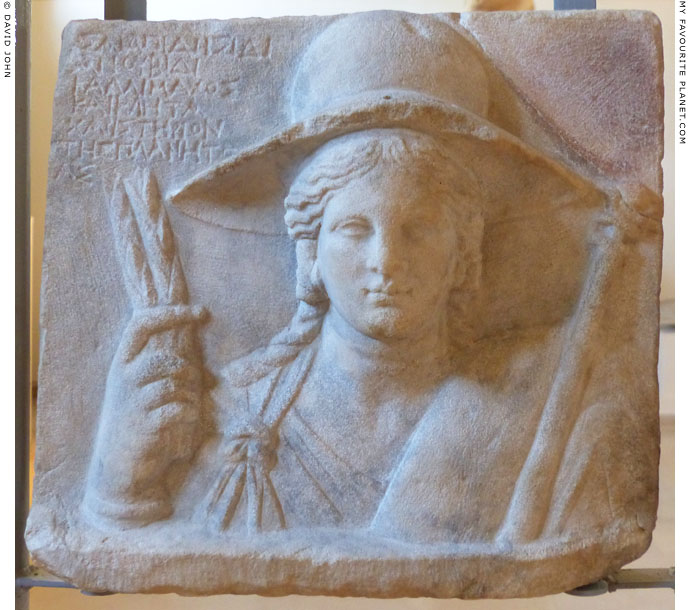
A marble relief of Isis-Demeter from the facade of the
main temple of the sanctuary of Isis. 2nd century BC.
Dion Archaeological Museum. Inv. No. 410.
|
Although Dion, the City of Dios (Ancient Greek, Δίον; Modern Greek, Δίο; Latin, Dium), was primarily dedicated to Zeus, other deities such as Dionysus and Asklepios were also worshipped here. Among the many sancturies, all of which were outside the city's walls, several areas were devoted to female deities, including Athena, Aphrodite, Artemis, Demeter, Hygieia, Isis and Nemesis.
The sanctuary of Demeter in Dion is one of the oldest places of worship of the goddess in northern Greece, and temples for her were built here from at least the Archaic period. The sanctuary included smaller buildings and altars for the worship of other deities associated with fertility and the underworld.
Several terracotta statuettes and other objects typical of votive offerings to Demeter as well as small marble statues, vases, lamps and jewellery have been discovered here and are now on display in the museum.
The mother goddess Demeter (Δημήτηρ), sister of Zeus and Hera, was one of the twelve Olympians, the major deities of the Greek pantheon. She was credited with the gift of agriculture to humans, and, along with her daughter Persephone (who was abducted by Hades), was associated with the underworld and the cycle of the seasons, life and death. In the Homeric Hymns she is referred to as "rich-haired Demeter, awful goddess", and "Queenly Demeter, bringer of seasons and giver of good gifts". [8]
Worship of Demeter included a mystery cult, particularly popular among women, which had its most important centre at Eleusis, northwest of Athens. Most of the details of the cult are unknown since initiates were sworn to secrecy. As the Greek historian Herodotus wrote:
"And of the mystic rites of Demeter, which the Hellenes call Thesmophoria, of these also, although I know, I shall leave unspoken all except so much as piety permits me to tell." [9]
Herodotus was convinced of the Egyptian origin of Greek gods, and in his work Histories he often compares the myths and worship of the gods of Egypt and Greece:
"... in the Egyptian tongue Apollo is Horus, Demeter is Isis, and Artemis is Bubastis." [10]
Alexander the Great was particularly fond of Isis, and when the worship of Egyptian deities spread through the Greek world in the Hellenistic period she was often represented with attributes of Greek goddesses such as Demeter and Tyche (Fortuna).
In the relief above, found on the steps of the main temple of the sanctuary of Isis, the subject has been identified as Demeter (Demeter as Isis, or Isis as Demeter?) and dated to the 2nd century BC, the time of the foundation of the sanctuary of Isis. [11]
The frontal view of the "rich-haired" goddess shows her with wavy hair, parted in the middle and gathered in thick plaits held by bands. Her strong face and broad nose are almost masculine, but her expression is gentle, perhaps motherly. Her thick neck and large, long-fingered hands also lend the impression of a robust agricultural worker, an impression added to by her large, broad-brimmed hat. She holds two ears of wheat (her gift to humanity) and a sceptre, usual attributes of the Greek grain deity.
In the Iliad, Homer also mentions her hair, and describes her active participation in the harvest of grain. You can almost see her rolling her sleeves up for her tasks:
"And even as the wind carrieth chaff about the sacred threshing-floors of men that are winnowing, when fair-haired Demeter amid the driving blasts of wind separates the grain from the chaff, and the heaps of chaff grow white." [12]
It is thought that the small hole in the front of the brim of her hat may have been drilled for the attachment of a metal solar disc between two bull's horns, a symbol known as the headdress or crown of the Egyptian goddess Hathor, which Isis is shown wearing in ancient Egyptian art. [13] The circle above/behind the hat is also thought to be Isis' solar disk, and the curve of the brim may have been designed to echo that of the horns of her emblem.
Although I have so far found no reference to the thick knot on the shoulder of her garment, I wonder if this is meant to represent the Egyptian tyet (welfare/life), a symbol of Isis also known as the Knot of Isis, Buckle of Isis or the Blood of Isis, thought to symbolize eternal life or resurrection.
The inscription in the top left corner of the relief states that it is dedicated by Kallimachos and Kleta to the triad Serapis-Isis-Anubis, Egyptian gods adopted in Greece during the Hellenistic period.
Σαράπιδι Ἴσιδι
Ἀνούβιδι
Καλλίμαχος
καὶ Κλήτα [.]
χαριστήριον
τῆς πλανητέας
Inscription SEG 48:788
(SEG, 48, 1998, 788)
|
To Sarapis, Isis
and Anubis
Kallimachos
and Kleta [.]
for thanks-offering
to the wandering (deity).
|
Height of relief 30.8 cm, width 34 cm, depth 4-8 cm. |

Marble head of Demeter from the
sanctuary of Demeter. 4th century BC.
Dion Archaeological Museum.
Inv. No. 200.
Discovered in 1973, the first year of
the most recent excavations at Dion
which are still ongoing. Archaeologists
from the Aristotle University of
Thessaloniki have been exploring
this site since 1928. |
| |
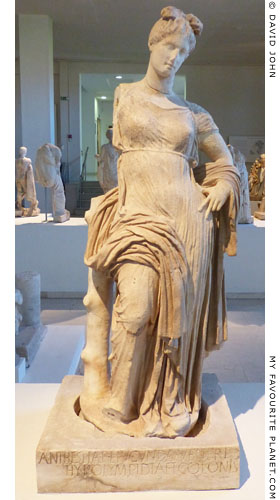
Cult statue of Aphrodite Hypolympiada
(Below Olympus), the local variant
of the foam-born goddess of love.
From the sanctuary of Isis. Marble,
2nd century BC. Height 1.60 m.
Dion Archaeological Museum.
Inv. No. 383. |
| |
|

"The philosophers of Dion", statues of four philosophers, from the Villa of Dionysos.
White marble. 180-192 AD. Reworked in the early 3rd century AD.
Dion Archaeological Museum. Inv. No. I.26.1-4.
The philosophers have gone to Rome where they are currently
appearing until October 2015 in the exhibition The Age of Anxiety From
Commodus to Diocletian, 180-305 AD in the Capitoline Museums. [14] |
| |

I'm only dreaming.
Painted terracotta head of a sleeping man. Part of a lifesize model of a deceased young man from
a tomb at Kastania, in the semi-mountainous region of North Pieria. Second half of the 4th century BC.
Dion Archaeological Museum. |
| |
Here is something you don't see every day, unless you live in Hollywood. Four of these "footsteps" (βηματα, bemata) votive offerings, also known as plantae pedum dedications, were discovered by archaeologists at the entrance to the temple of Isis. All dated to the 2nd century AD, they are are now in the archaeological museum [15]. In this example, the grey marble plaque has two sculpted footprints of different sizes, placed above a terse inscription from Getianos Pasiphilos, apparently a priest who may have been a pilgrim to Dion, addressed to Isis:
Γετιανὸς
Πασίφιλος
ἱερώμενος
Inscription SEG 34:624
(SEG, 34, 1984, 624)
|
Getianos
Pasiphilos
priest |
Height of plaque 42.5 cm, width 19.8 cm, depth 4.5 cm. Height of footsteps: left 21.7 cm, right 25 cm.
Conclusion
I would love to tell you more, and there is much more to tell, but I'm sure you have other things to get on with. I know I have. Hopefully, one day I can find time to put together a comprehensive travel guide to Dion.
We had a wonderful day in Dion, and I hope I shall visit the place again soon. It has now become one of my favourite places in northern Greece, and it is a lot more accessible - in several senses of the word - than many other places of historical interest, and relatively easy to get to from Thessaloniki. We recommend you go there immediately, and don't forget to take something to feed the geese. |
|

Footsteps from the sanctuary of Isis.
Late 2nd century AD.
Dion Archaeological Museum.
Inv. No. 420. |
|
|

Poster for a performance of Aristophanes' ancient Greek comedy Lysistrata about
sex and war at the Ancient Theatre of Dion as part of the annual Olympus Festival. |
|
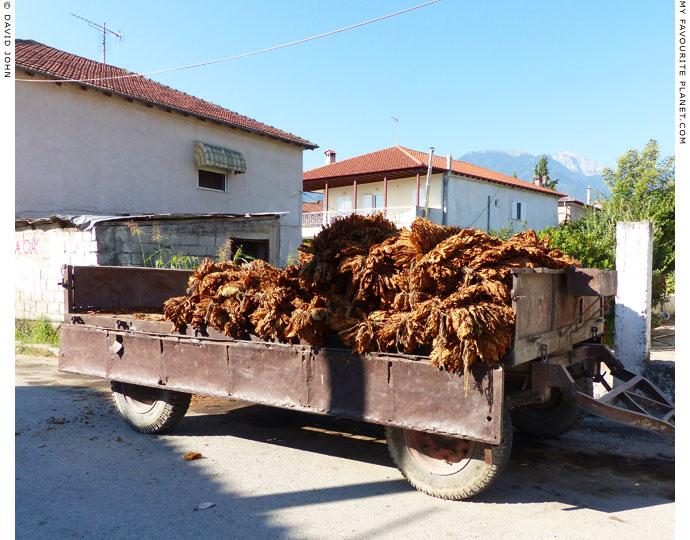
Tobacco of the gods.
|
Tobacco is still a major crop around Dion and other farmlands in Macedonia, although production has been declining for many years. The industry is no longer the source of great riches for the "tobacco barons" who once monopolized the weed trade during the Ottoman Empire (see an article about the Tobacco Museum in Kavala).
Nicotiana tabacum, the aromatic, small-leafed variety grown in Greece, the Balkans and Turkey, is known as "Oriental", "Balkan" and "Turkish". The annual herbaceous plant grows to a height of between 1 and 2 metres, and produces small, pink, tube-shaped flowers in the summer. The harvested leaves are usually dried in the sun at the farms before being transported to factories for processing into cigarettes and pipe tobacco. |
|

Tobacco plants growing in Dion. |
|
| |
| Dion |
Dion travel information |
|
 |
|
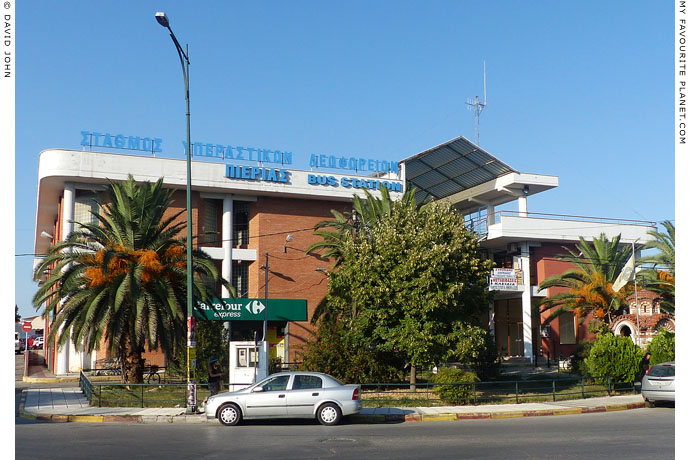
Katerini bus station. |
| |

Bus number 3 for Dion at the well-hidden bus stop in the centre of Katerini.
|
Dion Archaeological Park and Museum
Dion, 60100 Pieria, Macedonia, Greece.
Tel: +30 23510 53206
website: www.ancientdion.org
(Flash site in Greek, German and English)
Opening Hours
Winter (1 November - 31 March)
Archaeological Site: Daily 8:00 - 15:00
Archaeological Museum: Tuesday - Sunday 8:30 - 15:00.
Monday closed.
Summer (1 April - 31 October)
Archaeological Site: Daily 8:00 - 19:00
Archaeological Museum: Tuesday - Sunday 8:0 - 15:00.
Monday closed.
Tickets €4, Reduced €2. Valid for park and museum.
There is a café with a terrace and toilets in the park, and a couple of restaurants and shops opposite the museum entrance.
There is also a petrol station about 200 metres south of the museum.
How to get to Dion
Dion village is about 6 km west of the Aegean coast on the west side of Thermaic Gulf, in Central Macedonia, northern Greece.
Distances
440 km northeast of Athens,
85 km southwest of Thessaloniki,
15 km south of Katerini.
There are signposted junctions for Dion from the A1 "Aegean" Motorway (European Route E75) and National Road EO1 which connect Athens and Evzonoi, passing close to Thessaloniki. The motorway is a toll road. (For further information see How to get to Pella, Macedonia, Greece.) Dion is about 6 km west of these roads.
There are regular trains and inter-city KTEL buses every day from Thessaloniki and Athens to the town of Katerini, from where you can take a local bus or taxi to Dion.
There are no buses between Litochoro and Dion. From Litochoro take a bus to Katerini then a local bus to Dion.
Inter-city buses to Katerini
Katerini KTEL inter-city bus station is 15-20 minutes walk northeast of the town centre.
Inter-city buses to Katerini are operated by KTEL Pierias.
Website: www.ktelpierias.gr
(in Greek, English, German, Romanian, Russian, Serbian)
KTEL Pierias offices at bus stations
Katerini: 23510 46 720 and 23510 23313
Athens: 210 8317059
Thessaloniki: 2310 595428
Litochoro: 23520 81271
Inter-city buses Athens - Katerini
Buses from Athens to Katerini leave from Liossion Street KTEL inter-city bus station (also known a Terminal B), north of Athens city centre.
Athens "Terminal B" Bus Station
260 Liossion Street, Athens.
(Entrance in Agiou Dimitriou Aplon Street,
parallel to Liossion Street.)
There is no website for the Athens bus stations.
Athens > Katerini
Daily 9:45, 15:00, 22:00. Extra bus every Friday 17:00.
Katerini > Athens
Daily 9:30, 15:00, 24:00 (also goes to Piraeus, Sunday only).
Extra bus every Sunday 16:00.
(There are also connections between Katerini and Litochoro.)
Tickets: one-way €30, return €45.
Journey time: 5 hours 30 minutes.
Inter-city buses Thessaloniki - Katerini
Thessaloniki is a fascinating modern city, ideal as a base for exploring places in Western and Central Macedonia, such as Dion, Pella, Veria, Vergina, Edessa, Amphipolis ... The city also has excellent archaeological and Byzantine museums as well as several ancient monuments, churches, monasteries and the second longest city walls in Europe (after Istanbul).
See How to get to Macedonia, Greece for details of Thessaloniki airport, train and bus stations.
The website of KTEL Macedonia inter-city bus station in Thessaloniki has information about schedules and fares:
ktelmacedonia.gr/en/routes/tid=30
Thessaloniki > Katerini
Monday - Saturday buses every half hour 6:30 - 22:30,
departing at 15 and 45 minutes past the hour.
Fewer buses on Saturday and Sunday.
Katerini > Thessaloniki
Monday - Saturday buses every half hour 5:15 - 21:30,
departing on the hour and at 30 minutes past.
Fewer buses on Saturday and Sunday.
One-way ticket €6.30.
Journey time 50 minutes.
Trains to Katerini
Trains in Greece are run by OSE (Ο.Σ.Ε.):
www.ose.gr (Greek and English)
Train schedule and fare information at Trainose, the
official OSE website for passenger train information:
www.trainose.gr (Greek and English).
Train Stations
Athens: 210 529 77 77
Thessaloniki: 2310 517517
Katerini: 23510 23709
Katerini train station, about 20 minutes walk east of
the town centre, is on the Athens to Thessaloniki line.
Athens > Katerini
There are 5 trains daily each way between
Athens and Thessaloniki stopping at Katerini.
4 Intercity (IC) trains, ticket €41.20.
1 Regional (REG) train, ticket €20.90.
Journey time around 4-5 hours.
Thessaloniki > Katerini
There are 16 trains daily to and from Thessaloniki
stopping at Katerini:
4 Intercity (IC) trains between Thessaloniki and Athens;
10 Thessaloniki Suburban Railway (SUB; Greek, ΠΡΟΑ) trains between Thessaloniki and Larissa;
1 Regional (REG; Greek, ΑΠ) train travels between Thessaloniki and Palaeofarsalos via Larissa.
Journey time Thessaloniki - Katerini around 1 hour.
Ticket: €9 (Suburban Railway and Regional trains),
€12.10 (Intercity trains).
Return tickets save money, but are not always displayed on the Trainose website. Booking on the internet is cheaper than at stations. There are often special offers.
Local buses Katerini - Dion
Local buses are operated by Astiko KTEL Katerini.
Tel: 2351 037600 and 2351 046800-7
Website: www.astika-katerinis.gr
(Greek only; not very informative or user-friendly)
The bus stop for Dion is in Katerini town centre, hidden away on Odos Partheniou Vardaka, a small sidestreet near Plateia Eleftherias (Freedom Square). It is about 20 minutes walk from the railway station and the KTEL inter-city bus station. It is difficult to find, and you will probably need to ask directions.
Bus Number 3 runs between the centre of Katerini
and Dion about once an hour, Monday-Saturday.
One-way ticket €2.
Journey time around 25 minutes.
The bus stops 100 metres from the entrance to the archaeological museum. There is a large signpost to the museum opposite the bus stop.
Schedule Katerini to Dion (11 September 2014)
A timetable in Greek is taped to the inside of the glass shelter of the bus stop at Katerini.
Monday-Saturday
7:00, 7:50, 8:40, 9:30, 10:30, 11:30, 12:30,
13:35, 14:50, 16:30, 17:30, 19:00, 20:30
Sundays and holidays
8:00, 10:30, 13:00, 15:30, 18:00, 21:30
There is no timetable at the bus stop in Dion, but presumably the bus from Dion returns around half an hour or so after it leaves the city centre. Ask the driver or at the museum about times.
Taxis Katerini - Dion
There are plenty of taxis in Katerini, and the journey to Dion costs around 25 Euros. Arrange with your taxi driver, or take his telephone number if you want to return to Katerini by taxi.
Taxi Katerini
Website: taxikaterini.gr (Greek only)
Tel: 23510 21222, 23510 31222, 23510 18300
"Taxi within the city costs €10.
From Katerini a taxi TO ANY DESTINATION:
the first 200 km €1.50 per kilometre; and then €1 per kilometre.
Travel from anywhere outside Katerina, there is an extra charge of €0.60 on the total number of kilometres.
(Prices include VAT)." |

Statue of Eleftheria (Freedom)
on Eleftherias Square, Katerini. |
| |

The bus stop near the Dion Museum.
A typical village bus stop. |
| |

Signpost to Dion Museum and Mount
Olympus opposite the bus stop.
See a larger photo below.
The museum is less than 100 metres,
Olympus quite a bit further on. |
| |

The main road through Dion village,
south of the museum. Plenty of
signposts to local attractions. Notice
also the sign for the petrol station.
See larger photo below. |
| |

Taverna Ariadne, one of the restaurants
across the street from the archaeological
museum, declares its wares. |
| |
|

The view from the bus stop at Dion. Brown cultural signposts point the way
to the Archaeological Museum, less than 100 metres away, and Mount Olympus
which is considerably further: it is over 6 km from here just to the base of the
mountain. Olympus peeks (or peaks) over the rooftops of the village. |
| |

Signs along the main road through Dion, just south of the archaeological museum
and bus stop. A large panel of brown cultural signposts point the way to the
museum, the Mediterranean Mosaic Center, Mount Olympus, Koromilia Resort and the
Ourlia Gorge Waterfalls. The forested foothils of Olympus can be seen in the background. |
| |
| Dion |
Notes, references and links |
 |
|
1. Pausanias on Dion and the Baphyras River
"7. The Macedonians who dwell in the district below Mount Pieria and the city of Dium say that it was here that Orpheus met his end at the hands of the women. Going from Dium along the road to the mountain, and advancing twenty stades, you come to a pillar on the right surmounted by a stone urn, which according to the natives contains the bones of Orpheus.
8. There is also a river called Helicon. After a course of seventy-five stades the stream hereupon disappears under the earth. After a gap of about twenty-two stades the water rises again, and under the name of Baphyra instead of Helicon flows into the sea as a navigable river. The people of Dium say that at first this river flowed on land throughout its course. But, they go on to say, the women who killed Orpheus wished to wash off in it the blood-stains, and thereat the river sank underground, so as not to lend its waters to cleanse manslaughter."
Pausanias, Description of Greece, Book 9, chapter 30, sections 7-8. English Translation by W.H.S. Jones and H.A. Ormerod. Loeb Classical Library edition in 4 Volumes. Harvard University Press, Cambridge, MA; William Heinemann Ltd., London, 1918. At Perseus Digital Library.
For further information about Pausanias, see
the Pausanias page in the MFP People section.
2. Head of the river god Baphyras
Head of a youth, personification of the river god Baphyras
Marble, 2nd century AD.
Height 31 cm.
Dion Archaeological Museum.
Inv. No. 1053.
The original marble head of Baphyras is normally in Dion Archaeological Museum, but for some reason I could not find it. The photo is of a plaster cast made for the Greek Archaeological Receipts Fund (www.tap.gr) and on sale in many museum shops in Greece. Cast No. 263, price €105.
This one is (or was) on sale in the shop
of the Kavala Archaeological Museum.
3. William Martin Leake rediscovers Dion, 21 December 1806
Colonel William Martin Leake (1777-1860), British topographer, antiquarian and author; member of the Society of Dilettanti, Fellow of the Royal Society and expert in marine artillery.
William Martin Leake, Travels in Northern Greece Volume 3 (of 4), chapter 30, pages 408-413. J. Rodwell, London, 1835. At the Internet Archive.
4. Athenaeus on squid at Dion
Athenaeus of Naucratis (Greek, Ἀθήναιος Nαυκρατίτης or Nαυκράτιος; Latin, Athenaeus Naucratita) was a Greek rhetorician and grammarian of the late 2nd to early 3rd century AD from Naucratis, Egypt. The only of his works to have survived is the 15-volume Banquet of the Learned (Δειπνοσοφισταί, Deipnosophistae), written in Rome in the early 3rd century AD, most of which is still extant. The book is an account - probably fictional - of erudite conversations between diners at three banquets.
The Deipnosophists, or Banquet of the Learned of Athenaeus Volume I, translated by C. D. Yonge. Book 7, chapter 130, page 514. Henry G. Bohn, London, 1854. At Project Gutenberg.
The quote is allegedly from Life of luxury (Ἡδυπάθεια, Hedypatheia), a gastronomical travel guide to the Mediterranean by Archestratus (Ἀρχέστρατος), a 4th century BC Epicurean poet from Gela, Sicily. The work is only known from fragments and references by other authors.
5. The Marine Triumph of Dionysus mosaic
See:
Δημήτριος Παντερμαλής, Η ανασκαφή μιας αίθουσας συμποσίων στο Δίον (Dimitrios Pandermalis, The excavation of a banqueting hall at Dion). Το Αρχαιολογικό Έργο στη Μακεδονία και στη Θράκη (The Archaeological Work in Macedonia and Thrace), Volume 1, No. 1, 1987, Pages 181-188.
In a video interview in 2008 (see video below) Professor Pandermalis dates the Dionysus mosaic to the late 2nd century AD. |

Marble head of Zeus
from the ancient city of Dion.
2nd century AD. Height 21 cm.
Dion Archaeological Museum.
Inv. No. 46. |
| |

A restored monolithic column
in the sanctuary of Isis, Dion,
made of a single piece of
blue-grey veined marble,
with an Ionic capital. |
| |
6. The cult of Zeus Hypsistos
See, for example:
Mark Mueller, Hypsistos cults in the Greek world during the Roman Imperium. MA thesis. McMaster University, Ontario, Canada, 2014.
Jörg Lanckau, Hypsistos: cultural translation of Jewish monotheism in the Hellenistic period (in English). Asiatische Studien: Zeitschrift der Schweizerischen Asiengesellschaft, Band 65 (2011), Heft 4, pages 861-882. University of Zurich, 2011.
Björn Forsén, The sanctuary of Zeus Hypsistos and the assembly place on the Pnyx. Hesperia 62.4 (1993), pages 507-521. American School of Classical Studies at Athens, 1993.
Kalliopi G. Chatzinikolaou, Zeus Hypsistos – un dieu d’origine macédonienne ou bien orientale? Remarques sur la redatation de trois reliefs votifs inscrits de la Haute Macédoine (in French). XVII International Congress of Classical Archaeology, Rome, 22-26 September 2008.
7. Ancient river gods
See the article River Gods on Ancient Coins at forumancientcoins.
8. Homeric hymn to Demeter
Extracts from Hymn 2 to Demeter:
"I begin to sing of rich-haired Demeter, awful goddess..."
"Hecate, with a torch in her hands, met her, and spoke to her and told her news:
'Queenly Demeter, bringer of seasons and giver of good gifts...'"
Anonymous, The Homeric Hymns and Homerica. English Translation by Hugh G. Evelyn-White. Harvard University Press, Cambridge, MA. and William Heinemann Ltd., London, 1914. At Perseus Digital Library.
9 and 10. Herodotus on Demeter and Isis
Herodotus (Ἡρόδοτος, circa 484 - circa 425 BC), "the Father of History", Greek historian born in Halicarnassus, Caria (today Bodrum, Turkey).
9. Herodotus, Histories, Book 2, chapter 171.
10. Herodotus, Histories, Book 2, chapter 156.
The History of Herodotus, Volume I, Book II. Translated into English by G. C. Macaulay. MacMillan and Co., London and New York, 1890. At Project Gutenberg.
See a brief profile of Herodotus and photos of portraits of the historian in the My Favourite Planet People section.
11. Female deities at Dion
See:
Semeli Pingiatoglou (Department of Archaeology, University of Thessaloniki), Cults of Female Deities at Dion. Illustrated and with bibliographical references. Kernos 23 (2010), pages 179-192. At Kernos Revues.
Panayotis Pachis (Aristotle University of Thessaloniki), Induction into the mystery of "star-talk": The case of the Isis cult during the Graeco-Roman Age. Pantheon, Volume 7, Number 1, pages 79-118.
Although several authors have also cited the dating of this relief to the 2nd century BC, some sources state that it is of the Roman Imperial period, and most refer to Isis without mentioning Demeter. It appears that there is some confusion about the dating of several artefacts found at Dion, and many have not yet been "published", meaning they have not been thoroughly studied or analyzed.
12. Homer on Demeter
Homer, The Iliad, Book 5, lines 493-532. English Translation by A.T. Murray, in two volumes. Harvard University Press, Cambridge, MA. and William Heinemann Ltd., London, 1924. At Perseus Digital Library.
13. The hat of Isis-Demeter
See a discussion of this and other reliefs and inscriptions from the sanctuary of Isis at Dion:
Perikles Christodoulou, Les reliefs votifs du sanctuaire d’Isis à Dion (in French). In: Laurent Bricault & Richard Veymiers (editors), Bibliotheca Isiaca, II, pages 11-22. Ausonius Éditions, Bordeaux, 2011. At academia.edu. Illustrated, with bibliography.
Christodoulou also briefly compares the style of execution of the stele to 2nd century BC figurines depicting Athena discovered at Pella. See also note 15 below.
14. The Age of Anxiety exhibition, Rome
"L'Età dell'angoscia da Commodo a Diocleziano 180-305 d.c." (The Age of Anxiety From Commodus to Diocletian 180-305 AD), exhibition until October 2015 in the Palazzo dei Conservatori of the Capitoline Museums, Rome.
I went to see the exhibition in Rome and found it very odd. The concept seems a bit weak and the exhibits, apart from a few portraits of doomed emperors, do not really communicate the anxiety of the show's title. I did not buy the catalogue (34 Euros, Italian only) and the curator's logic is not evident from the exhibits alone.
Most items are sculptures from the Capitoline itself and other Roman museums, as well as a number of objects from museums in other countries, including Germany, USA and Greece.
Notably, there are seven pieces from the villa of the wealthy Athenian Herodes Atticus (circa 101-177 AD) in Loukou, Arcadia, five of which are displayed lying in a box full of small, brown pebbles, presumably to lend them an "archaeological" context or because of their woefully unrestored condition (especially in Rome where ancient sculptures have been notoriously over-restored). None are either unique or particularly important ("male portrait", "male bust", etc.; although there is a decent bust of Septimius Severus, a head of Commodus and part of a copy of Artemis Ephesia) and they barely squeeze into the historical timeframe of the exhibtion, since Atticus died in 177 AD and the latest work of the selection is an anonymous "male portrait" dated to 250-275 AD. However it was interesting to see these few works from a very important and much neglected collection available to the public again. Over 100 sculptures, several inscriptions, mosaics and other works from the Villa of Herodes Atticus currently languish in the Archaeological Museum of Astros which has been closed for many years.
See an excellent short video in English about the Villa of Herodes Atticus and the Archaeological Museum of Astros, including an interview with archaeologist Theodore Spyropoulos, head of archaeological services in the Peloponnese. Miracle in Arcadia, Carmen Films, 2014:
www.youtube.com/watch?v=jqQFyaLRWEY at YouTube. 8 minutes 46 seconds.
Otherwise I feel it would have been better, in this case at least, to leave many of the exhibits in their home museums. It is a frustrating business visiting a museum, often requiring considerable travel, to see particular exhibits, especially "star" items, only to find they are on loan to other museums. On a recent visit to the Naples Archaeological Museum, for instance, I found many rooms were closed due to staff shortages, and dozens of important objects were out on long loans.
This seems to be happening more often, and we appear to be in something of a museum loan frenzy. Such shows have benefits for lender and borrower institutions, scholars and those not able to travel, of course, but still... Remind me write a blog about it sometime.
See The Cheshire Cat's rant about museums at Museum BOOM part 1.
15. plantae pedum dedications
These reliefs are discussed in the article by Perikles Christodoulou [see note 13], which is cited in a discussion of the plantae pedum dedications from Dion by Louise Revell:
Louise Revell, Footsteps in stone: Variabilty within a global culture. In: Susan E. Alcock, Mariana Egri, James F. D. Frakes (editors), Beyond Boundaries: Connecting Visual Cultures in the Provinces of Ancient Rome, pages 206-221. Getty Publications, Los Angeles, 2016. |
|
|
| |
| |
Professor Dimitrios Pandermalis on the excavations at Dion, 2008.
Presentation of the excavations at Dion by the Director of the University excavation programme,
Emeritus Professor Dimitrios Pandermalis, Aristotle University of Thessaloniki.
Filmed as part of the project "Digital recording, documentation
and promotion of the Dion Archaeological Park".
Director: Pericles Pangiotidis. Produced by GeoAnalysis S.A. and Polyline S.A., 2008.
The Greek version of this video: www.youtube.com/watch?v=q-6Q8leplmU |
| |
Photos and article by David John © 2014-2015
Additional photos by © Konstanze Gundudis

The Cheshire Cat Blog at My Favourite Planet Blogs
We welcome considerate responses to these articles
and all other content on My Favourite Planet.
Please get in contact.
The photos on this page are copyright protected.
Please do not use them without permission.
If you wish to use any of the photos for your website,
blog, project or publication, please get in contact.
Higher resolution versions are available on request. |
 |
Visit the My Favourite Planet Group on Facebook.
Join the group, write a message or comment,
post photos and videos, start a discussion... |
|

Clouds gather around Mount Olympus while the Pierian Plain around Dion remains bright and sunny. |
Views of blog authors do not necessarily reflect those of the publishers
or anyone else at, on or in the vicinity of My Favourite Planet. |
 |
| |
|
|
| |
| |
 |
| |
 |
| |
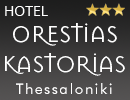 |
| |
 |
| |
 |
| |
 |
| |
George Alvanos
rooms
in Kavala's historic Panagia District
Anthemiou 35,
Kavala, Greece
kavalarooms.gr |
| |
| |
Olive Garden Restaurant
Kastellorizo,
Greece +30 22460 49 109
kastellorizo.de |
| |
| |
Papoutsis
Travel Agency
Kastellorizo,
Greece +30 22460 49 286
greeklodgings.gr |
| |
| |
|